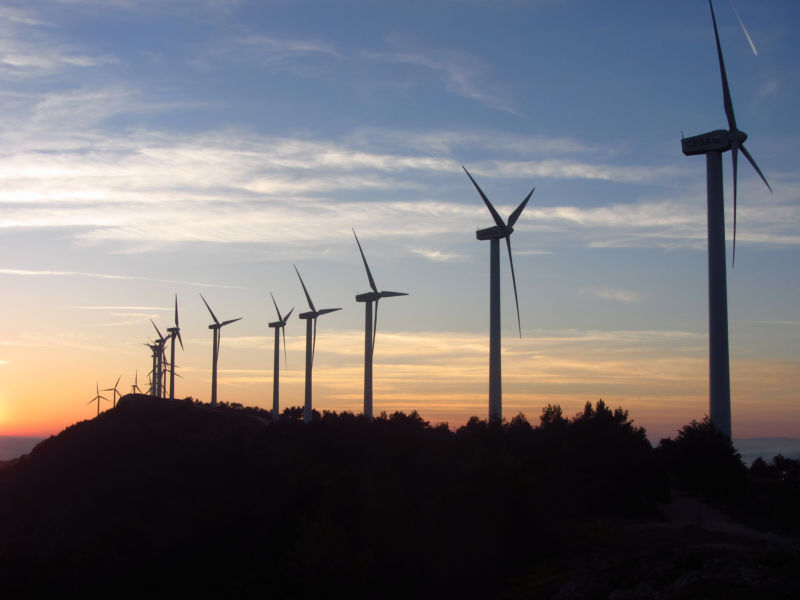
[ad_1]

The solution to climate change is, at least conceptually, simple. Activities that add greenhouse gases to the atmosphere—chiefly the use of fossil fuels—need to be changed or eliminated. Of course, not every alternative to fossil fuels will be equally beneficial. Technologies have to be evaluated for costs and benefits. One thing we know about wind turbines, for example, is that they can alter local temperatures by increasing the mixing of air at and above the surface.
Setting aside inevitable but ignorant claims that “wind turbines are just as bad as coal plants” (they aren’t by a longshot), it does make sense to think seriously about the effect turbines have on local temperature. Harvard’s Lee Miller and David Keith set out to fill some holes in our knowledge by simulating a less-than-implausible scenario in which the US produces all its electricity with wind power. At this scale, they wondered, what does the trade-off between fossil fuels and wind power look like?
High-wind scenario
To find out, Miller and Keith turned to a high-resolution climate model of the continental United States. In the middle third of the country—where winds are higher—they placed enough virtual wind turbines to produce almost half a terawatt of electricity. This would meet 100 percent of current US demand.
The results of their simulation showed that the continental US got about 0.2°C warmer, on average, with the turbines in place. Within the wind-turbine-hosting region, that number was more like 0.5°C. That falls roughly in line with previous real-world measurements around wind farms.
The temperature change is larger at night and smaller during the day, because surface warming and convection driven by the Sun overwhelm the influence of the turbines. But when the air is calmer at night, the turbines help mix warmer air down toward the cooling surface. That’s why this is essentially an instantaneous but reversible effect. Turbines don’t add energy to the atmosphere—they just move some air around.
The researchers attempt to estimate the climate benefit of these turbines for comparison. But doing this in a truly apples-to-apples way is tricky. While the temperature change caused by turbines mixing air is purely local, the benefit of reduced greenhouse gas emissions is felt globally—meaning that wind turbines in one location are purely beneficial everywhere else in the world. And while the local effect of a turbine ends when you turn it off, warming caused by greenhouse gases continually accumulates and lasts for centuries.
Global warming also includes myriad changes to precipitation and extreme weather patterns beyond the difference on your thermometer. This doesn’t even get into other consequences of fossil fuel emissions, like ocean acidification or pollutants that directly impact human health.
Thinking globally
Still, Miller and Keith make their best estimate. In their analysis, they calculated the global warming avoided if the US—and every other country—eliminated its power-plant emissions by 2080. (This doesn’t include other sources of greenhouse-gas emissions.) In that hypothetical scenario, the avoided warming in the US in 2100 would actually be roughly equivalent to the added local warmth caused by the wind turbines. Obviously, if the only reductions in greenhouse-gas emissions came from the US, the local benefit would be much smaller.
The list of caveats for accurately interpreting these results is long. Beyond those already mentioned, electrifying the energy used by buildings and transportation with those wind turbines would add considerably to the climate benefit. But doing so would also require more turbines and thus increase their negative impact somewhat.
On the other side of the ledger, it’s unclear what the combination of wind-turbine impacts and benefits would mean for US agricultural production, to give one example. And the specific locations of the wind turbines can alter their impacts, so simulating a scenario of turbines spread evenly over the middle of the country can only tell you so much. This study scratches the surface of a complex question.
But the researchers point out that replacing all the wind turbines in their scenario with solar panels would probably have just one-tenth the local warming effect—about 0.02°C averaged over the continental US. Solar panels affect local temperatures in a very different way, by changing the among of sunlight absorbed on the surface. Since solar panels can produce the same amount of electricity in a much smaller area, their influence isn’t felt as broadly.
“Wind beats fossil fuels under any reasonable measure of long-term environmental impacts per unit of energy generated,” the researchers write. But nothing is free, wind power included. They add, “While these impacts differ from the climate impacts of [greenhouse gases] in many important respects, they should not be neglected.”
So, as we develop and choose the mix of energy sources that will keep the grid humming forward, this is one more factor to consider.
Joule, 2018. DOI: 10.1016/j.joule.2018.09.009 (About DOIs).
Source link